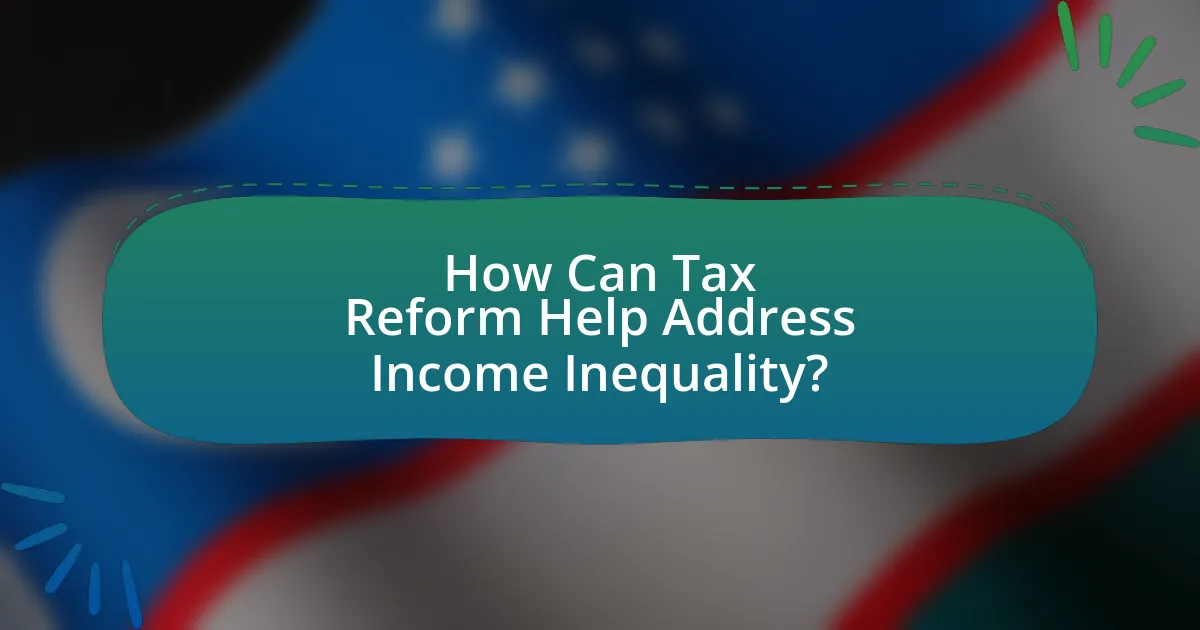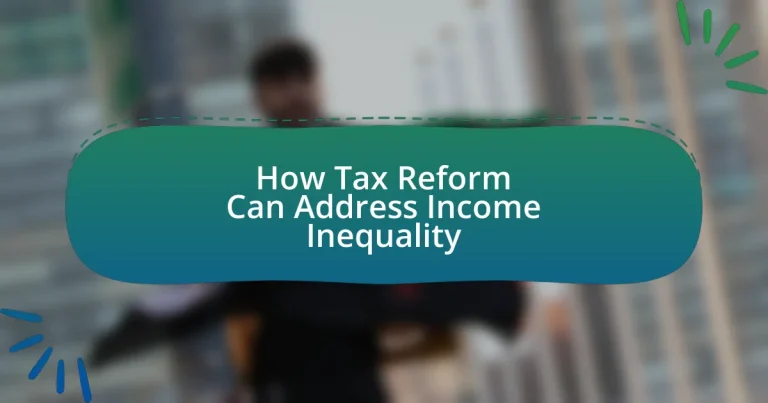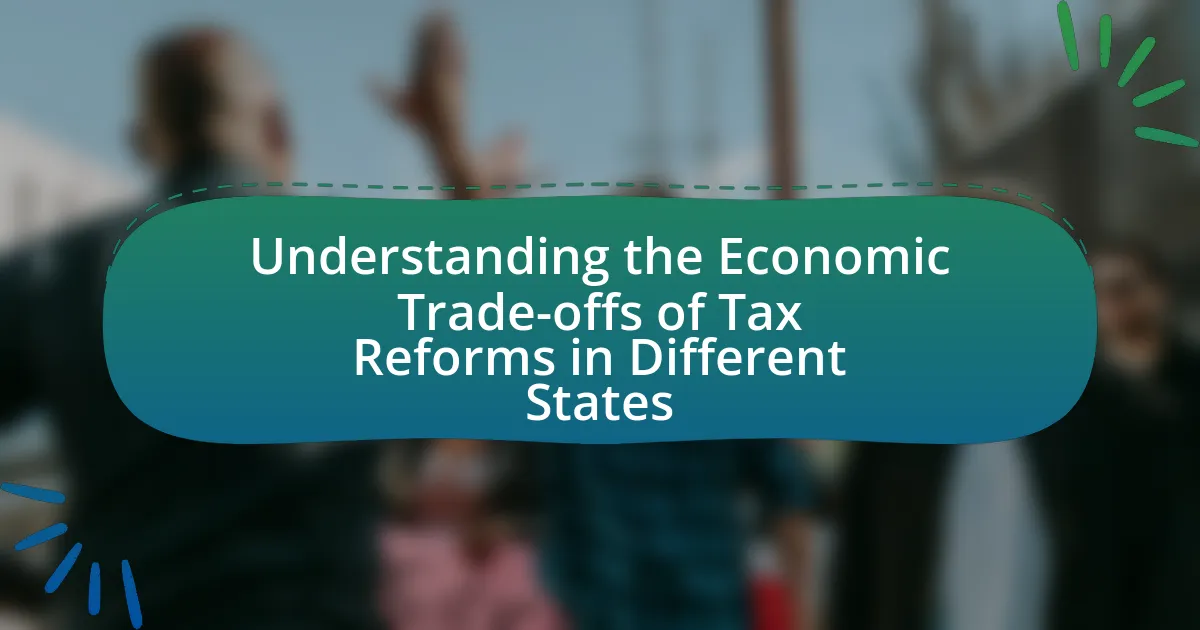Tax reform is a critical tool for addressing income inequality through mechanisms such as progressive taxation, which requires higher earners to contribute a larger share of their income. This article examines how tax reform can redistribute wealth, enhance funding for essential social programs, and provide financial relief to low-income households through targeted tax credits and deductions. It also discusses the social and economic impacts of income inequality, the effectiveness of progressive tax systems, and the challenges and best practices in implementing equitable tax reforms. By analyzing case studies and international comparisons, the article highlights the potential of tax reform to promote a more equitable distribution of resources and foster economic growth.

How Can Tax Reform Help Address Income Inequality?
Tax reform can help address income inequality by redistributing wealth through progressive taxation, which imposes higher tax rates on higher income brackets. This approach ensures that wealthier individuals contribute a fairer share of their income, thereby funding social programs and services that benefit lower-income populations. For instance, the Congressional Budget Office reported that a more progressive tax system could reduce income inequality by increasing government revenue, which can be allocated to education, healthcare, and social safety nets. These investments can enhance opportunities for disadvantaged groups, ultimately narrowing the income gap.
What are the key principles of tax reform aimed at reducing income inequality?
Key principles of tax reform aimed at reducing income inequality include progressive taxation, closing tax loopholes, and increasing tax credits for low-income individuals. Progressive taxation ensures that higher income earners pay a larger percentage of their income in taxes, which can redistribute wealth more equitably. Closing tax loopholes prevents wealthier individuals and corporations from avoiding taxes, thereby increasing government revenue that can be used for social programs. Increasing tax credits, such as the Earned Income Tax Credit, directly benefits low-income families, providing them with additional financial support. These principles are supported by studies indicating that progressive tax systems can lead to lower income inequality, as evidenced by countries with higher tax rates on the wealthy showing reduced income disparity.
How do progressive tax systems contribute to income redistribution?
Progressive tax systems contribute to income redistribution by imposing higher tax rates on individuals with higher incomes, thereby reducing income inequality. This structure allows governments to collect more revenue from wealthier citizens, which can then be allocated to social programs and services that benefit lower-income populations. For instance, in the United States, the top 1% of earners contribute approximately 40% of federal income taxes, which funds essential services like education, healthcare, and welfare programs aimed at supporting disadvantaged groups. This mechanism effectively redistributes wealth and helps to level the economic playing field, promoting greater equity within society.
What role do tax credits and deductions play in alleviating income inequality?
Tax credits and deductions play a significant role in alleviating income inequality by reducing the tax burden on lower-income individuals and families, thereby increasing their disposable income. These financial incentives are designed to support those with limited resources, allowing them to retain more of their earnings. For instance, the Earned Income Tax Credit (EITC) has been shown to lift millions of families out of poverty each year; in 2020, it benefited approximately 25 million workers and their families, providing an average credit of about $2,000. Additionally, deductions for expenses such as childcare and education further assist low-income households by lowering their overall tax liability, which can lead to improved economic stability and opportunities for upward mobility.
Why is income inequality a pressing issue in today’s society?
Income inequality is a pressing issue in today’s society because it exacerbates social tensions and undermines economic stability. The gap between the wealthy and the poor has widened significantly, with the top 1% of earners in the United States holding more wealth than the bottom 90% combined, according to data from the Federal Reserve. This disparity leads to reduced access to essential services such as education and healthcare for lower-income individuals, perpetuating a cycle of poverty. Furthermore, income inequality can hinder overall economic growth, as lower-income households tend to spend a larger portion of their income, driving demand for goods and services. Addressing this issue through tax reform could promote a more equitable distribution of resources, fostering social cohesion and economic resilience.
What are the social and economic impacts of income inequality?
Income inequality has significant social and economic impacts, including increased poverty rates and reduced economic mobility. Socially, high levels of income inequality can lead to social unrest, decreased trust in institutions, and increased crime rates, as evidenced by studies showing that countries with greater income disparities often experience higher levels of violence and social discord. Economically, income inequality can hinder overall economic growth by limiting access to education and healthcare for lower-income individuals, which in turn reduces their productivity and contribution to the economy. Research from the International Monetary Fund indicates that countries with lower income inequality tend to have more sustainable economic growth, as equitable income distribution fosters a larger consumer base and stimulates demand.
How does income inequality affect different demographics?
Income inequality affects different demographics by exacerbating disparities in access to education, healthcare, and economic opportunities. For instance, lower-income families often face barriers to quality education, which limits their ability to secure well-paying jobs, perpetuating the cycle of poverty. According to the Pew Research Center, in 2020, the wealth gap between the top 20% and the bottom 20% of earners in the U.S. was 7.4 times greater, highlighting the significant economic divide. Additionally, racial and ethnic minorities are disproportionately affected by income inequality, as systemic barriers and discrimination contribute to lower income levels and reduced access to resources. The Economic Policy Institute reports that Black and Hispanic workers earn significantly less than their white counterparts, further illustrating how income inequality intersects with race.
What evidence supports the effectiveness of tax reform in reducing income inequality?
Tax reform can effectively reduce income inequality, as evidenced by studies showing that progressive tax policies lead to a more equitable distribution of wealth. For instance, research by the International Monetary Fund (IMF) indicates that countries implementing progressive tax systems experience a decrease in income inequality, with a notable correlation between higher tax rates on the wealthy and reduced income disparities. Additionally, data from the Organisation for Economic Co-operation and Development (OECD) demonstrates that tax reforms aimed at increasing the tax burden on higher income brackets can significantly lower the Gini coefficient, a common measure of income inequality. These findings illustrate that targeted tax reforms can play a crucial role in addressing income inequality.
What case studies demonstrate successful tax reform initiatives?
Case studies that demonstrate successful tax reform initiatives include the 1986 Tax Reform Act in the United States and the 2017 Tax Cuts and Jobs Act. The 1986 Tax Reform Act simplified the tax code, reduced the number of tax brackets, and eliminated many tax shelters, resulting in increased compliance and revenue. According to the Congressional Budget Office, this reform led to a significant increase in tax revenue and economic growth. The 2017 Tax Cuts and Jobs Act aimed to stimulate the economy by lowering corporate tax rates and providing tax cuts for individuals, which, according to the Tax Foundation, resulted in increased investment and job creation. Both cases illustrate how targeted tax reforms can enhance economic performance and address income inequality by promoting growth and increasing government revenue.
How do international comparisons illustrate the impact of tax policies on income inequality?
International comparisons demonstrate that tax policies significantly influence income inequality by revealing disparities in wealth distribution across different countries. For instance, Scandinavian countries like Sweden and Denmark implement progressive tax systems that redistribute wealth effectively, resulting in lower income inequality, as evidenced by their Gini coefficients, which are among the lowest globally. In contrast, countries with regressive tax structures, such as the United States, exhibit higher levels of income inequality, reflected in their higher Gini coefficients. These comparisons highlight how varying tax policies can lead to substantial differences in income distribution and social equity, underscoring the role of taxation in shaping economic outcomes.
How can tax reform be designed to be equitable and effective?
Tax reform can be designed to be equitable and effective by implementing a progressive tax system that increases rates for higher income brackets while providing relief for lower-income individuals. This approach ensures that those with greater financial capacity contribute a fairer share, thereby reducing income inequality. Historical data from countries with progressive tax systems, such as Sweden and Denmark, demonstrate that these models lead to lower income disparities and improved social welfare outcomes. Additionally, incorporating tax credits and deductions targeted at low- and middle-income families can enhance the effectiveness of tax reform by directly alleviating financial burdens and promoting economic mobility.
What are the challenges in implementing fair tax reform?
Implementing fair tax reform faces several challenges, including political resistance, complexity in tax code adjustments, and public perception. Political resistance arises from differing ideologies regarding taxation and government spending, often leading to gridlock in legislative processes. The complexity of existing tax codes makes it difficult to create reforms that are both equitable and efficient, as changes can have unintended consequences on various income groups. Additionally, public perception can hinder reform efforts; many individuals may fear that tax increases will disproportionately affect them or that benefits will not be equitably distributed. These challenges complicate the pursuit of tax reforms aimed at addressing income inequality effectively.
How can policymakers ensure that tax reforms benefit lower-income households?
Policymakers can ensure that tax reforms benefit lower-income households by implementing progressive tax structures that increase tax rates on higher incomes while reducing the tax burden on lower-income earners. For instance, the Tax Policy Center reported that a progressive tax system can lead to a more equitable distribution of wealth, as it allows for increased funding for social programs that directly support lower-income families. Additionally, targeted tax credits, such as the Earned Income Tax Credit, have been shown to lift millions of families out of poverty, demonstrating the effectiveness of such reforms in providing financial relief to those in need.
What are the potential drawbacks of tax reform in addressing income inequality?
Tax reform can exacerbate income inequality by disproportionately benefiting higher-income individuals and corporations. For instance, tax cuts aimed at stimulating economic growth often favor wealthier taxpayers, leading to a widening income gap. According to a 2017 report by the Congressional Budget Office, the Tax Cuts and Jobs Act resulted in a significant reduction in tax rates for the top earners, which critics argue undermines efforts to achieve equitable income distribution. Additionally, tax reforms may reduce funding for essential public services, further impacting lower-income populations who rely on these services for support.
How might tax reform impact economic growth and job creation?
Tax reform can stimulate economic growth and job creation by increasing disposable income for consumers and incentivizing business investment. When tax rates are lowered, individuals have more money to spend, which can boost demand for goods and services, leading to higher production levels and the need for more workers. For instance, the Tax Cuts and Jobs Act of 2017 in the United States resulted in a corporate tax rate reduction from 35% to 21%, which encouraged companies to invest in expansion and hiring. According to the U.S. Bureau of Economic Analysis, this reform contributed to a GDP growth rate of 2.9% in 2018, demonstrating a direct correlation between tax policy changes and economic performance.
What unintended consequences could arise from tax reform efforts?
Unintended consequences from tax reform efforts can include increased income inequality, economic distortions, and reduced government revenue. For instance, if tax cuts disproportionately benefit higher-income individuals, the wealth gap may widen, counteracting the reform’s goal of addressing income inequality. Additionally, changes in tax policy can lead to businesses altering their investment strategies, potentially resulting in economic inefficiencies. Historical examples, such as the Tax Cuts and Jobs Act of 2017 in the United States, demonstrated that while corporate tax rates were lowered, the benefits were not evenly distributed, leading to concerns about long-term fiscal sustainability and equity.
What best practices can guide successful tax reform initiatives?
Successful tax reform initiatives should prioritize transparency, stakeholder engagement, and evidence-based policy design. Transparency ensures that the reform process is open, allowing citizens to understand the changes and their implications, which builds trust. Engaging stakeholders, including taxpayers, businesses, and advocacy groups, fosters collaboration and helps identify diverse perspectives and needs, leading to more equitable outcomes. Evidence-based policy design relies on data and research to inform decisions, ensuring that reforms effectively address income inequality. For instance, the Tax Policy Center’s analysis demonstrates that targeted tax credits can significantly reduce poverty rates, highlighting the importance of data-driven approaches in tax reform.
How can stakeholder engagement improve tax reform outcomes?
Stakeholder engagement can improve tax reform outcomes by ensuring that diverse perspectives are considered, leading to more equitable and effective policies. Engaging stakeholders, such as taxpayers, businesses, and advocacy groups, allows policymakers to identify the specific needs and concerns of different segments of the population. For instance, research by the International Monetary Fund indicates that inclusive tax policy discussions can enhance compliance and public trust, ultimately resulting in higher revenue generation. Furthermore, stakeholder input can help identify potential unintended consequences of proposed reforms, allowing for adjustments that mitigate negative impacts on vulnerable populations. This collaborative approach fosters a sense of ownership and accountability among stakeholders, which is crucial for the successful implementation of tax reforms aimed at addressing income inequality.
What role does public awareness play in supporting tax reform efforts?
Public awareness plays a crucial role in supporting tax reform efforts by mobilizing public opinion and influencing policymakers. When citizens are informed about the implications of tax policies, they are more likely to advocate for reforms that address income inequality, as evidenced by studies showing that increased public engagement correlates with legislative changes. For instance, the 2017 Tax Cuts and Jobs Act faced significant public scrutiny, leading to ongoing debates about its fairness and impact on income distribution. This demonstrates that informed citizens can pressure lawmakers to consider equitable tax reforms that benefit lower and middle-income groups, ultimately fostering a more just economic system.




